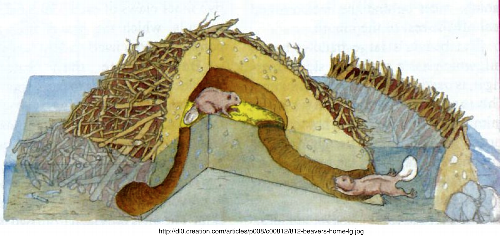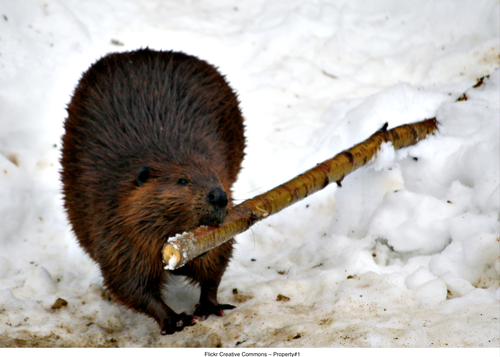Gearing up for Winter
Throughout the year, the North American beaver (Castor canadensis) is known for felling stands of trees - particularly those that are young and fast-growing - to be dragged away whole and used for dams or lodges. In the Fall, the beaver works especially hard to prepare for oncoming winter. After beavers use tree limbs to construct dams, beavers create giant piles of limbs in the water for winter lodging, which can stand over 7 feet  above the water. These lodges have a fascinating design. In the heart of the lodge is a cove just big enough for a family of beavers to live in during winter. The top of the lodge has a small hole for air, but the rest is a tight, thick latticework of sticks that traps in heat and blocks out cold winds. Lastly, the lodge leaves a space underneath to provide a tunnel connecting the lodge to a food cache.
above the water. These lodges have a fascinating design. In the heart of the lodge is a cove just big enough for a family of beavers to live in during winter. The top of the lodge has a small hole for air, but the rest is a tight, thick latticework of sticks that traps in heat and blocks out cold winds. Lastly, the lodge leaves a space underneath to provide a tunnel connecting the lodge to a food cache.
While lodges are under construction, beavers also float tree limbs near to their lodge, creating a stick pile of hundreds of pounds in weight. These limbs serve as a food supply in the winter when it’s too cold for beavers to trek beyond the riverbanks. To keep these sticks in place, beavers bury the sticks into the bottom of the river and leave part sticking out the top of the water. Once the top of the river freezes, the sticks are held in place under water for the beavers to access.
Amidst all this preparation, beavers make sure they are well fed. Fall is a time for beavers to build up body fat, giving them both better insulation and energy availability in the winter.

Embracing the Cold
When winter hits, beavers start to adapt to their new life of seclusion and darkness. Beavers are primarily nocturnal creatures, but life inside of a lodge is perpetual darkness. Interestingly, beavers know to leave their lodge for food during the night even without any external cues. One explanation is that they’re governed by their own circadian rhythms, which naturally alert them when it’s dark. However, after spending months in the lodge with no external signals to provide feedback, beavers are thrown off their cycle and their typical schedule becomes irrelevant.
Beavers spend almost the entire day sleeping or resting in their lodge. In the coldest temperatures, adult beavers are able to tolerate major body temperature fluctuations, and can at times reduce their average body temperature by 1 degree Celsius.
 Given their low energy expenditure and high fat reserves, the beaver only needs to dive underwater for food about once per day. Beavers leave through their “tunnel,” which provides easy access to their underwater food without having to break through ice. During their dives, beavers lower their heart rate and limit energy use to dive for about 15 minutes. They bring sticks back to their relatively warm lodge to eat. Although the food supply is generally abundant, sticks obviously have minimal nutritional value (very few calories). Beavers naturally compensate for this poor nutrition by harnessing cellulose-digesting bacteria in their gut, and recycle their nutrients by eating their feces.
Given their low energy expenditure and high fat reserves, the beaver only needs to dive underwater for food about once per day. Beavers leave through their “tunnel,” which provides easy access to their underwater food without having to break through ice. During their dives, beavers lower their heart rate and limit energy use to dive for about 15 minutes. They bring sticks back to their relatively warm lodge to eat. Although the food supply is generally abundant, sticks obviously have minimal nutritional value (very few calories). Beavers naturally compensate for this poor nutrition by harnessing cellulose-digesting bacteria in their gut, and recycle their nutrients by eating their feces.
________________________________________________________________________
*For more facts about the beaver in the Adirondacks, visit: http://courses.hamilton.edu/beavers/what-is-the-beaver
